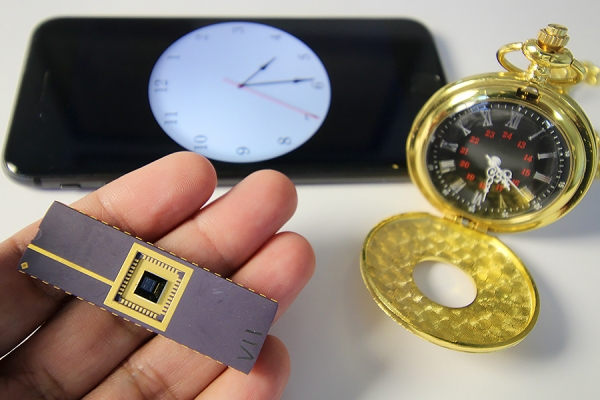 Engineering professor Jalal Ahamed is leading a $320,000 research project that could revolutionize the way devices keep track of time.
Engineering professor Jalal Ahamed is leading a $320,000 research project that could revolutionize the way devices keep track of time.
UWindsor engineering professor Jalal Ahamed knows timing is everything.
 Dr. Ahamed is leading a research project to improve the time-keeping chip embedded in every smart and connected device. Think cell phones, tablets and laptops, but also other connected devices like thermostats, security systems, refrigerators, automobiles, and airplanes.
Dr. Ahamed is leading a research project to improve the time-keeping chip embedded in every smart and connected device. Think cell phones, tablets and laptops, but also other connected devices like thermostats, security systems, refrigerators, automobiles, and airplanes.
Ahamed’s research aims to develop microchips that oscillate with high precision, providing a fixed frequency to measure time. They provide the reference frequency needed to synchronize events in digital integrated circuits, manage data transfer, define radio frequencies, process signals, as well as tell time.
“The novelty of this project is to use innovative device design combined with a robust material,” said Ahamed. “We are designing a better chip that is easier to manufacture and less expensive.”
For the past century, keeping time has been the dominion of quartz, a hard crystalline mineral. But quartz is expensive and difficult to cut and etch, Ahamed explained.
Ahamed is experimenting with tuning silicon as a replacement for quartz. He believes his oscillating microchip can replace traditional quartz-based devices.
“We need to develop a highly stable oscillator that vibrates at a fixed frequency in all conditions,” he said. This includes variations in temperatures ranging from -40C to 100C.
Ahamed said if he can make silicon as thermally stable as quartz, its use would reduce manufacturing costs and could be a game-changer in global markets. It would improve Canada’s competitiveness in the fields of semiconductor and communications technology manufactured domestically.
To conduct his research, Ahamed has been awarded an Alliance Mission grant of $200,000 over two years from the Natural Sciences and Engineering Research Council of Canada (NSERC). For the project, Ahamed has partnered with Stathera Inc., a Montreal-based company that specializes in micro-electro-mechanical systems (MEMS). Stathera will contribute $120,000 in in-kind support over the two years of the research project.
“The grant creates unique opportunities for industry-university-based collaboration that is not usually accessible by most grants,” said Anosh Daruwalla, manager of MEMS and process engineering at Stathera. “With the acceptance of this grant, Stathera is looking to make seminal breakthroughs in research and development towards the MEMS timing field with its partnership with UWindsor.”
According to NSERC, Alliance Mission grants are aimed at “addressing critical science and technology challenges that can play a pivotal role in Canada’s economy.”
—Sarah Sacheli
